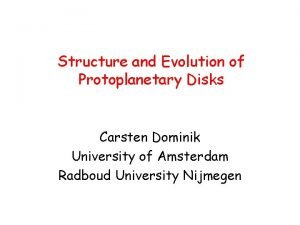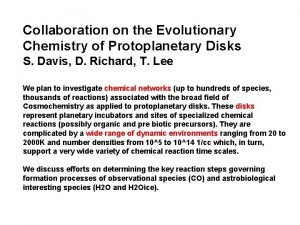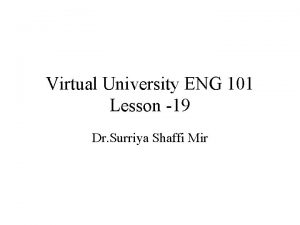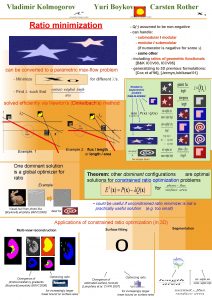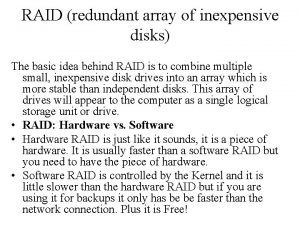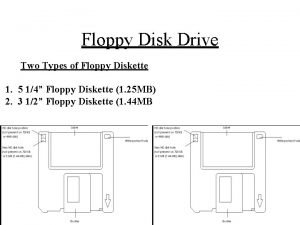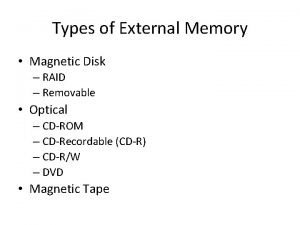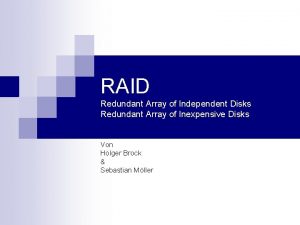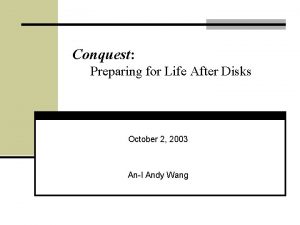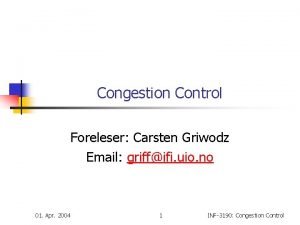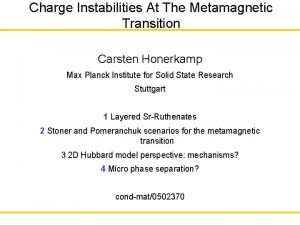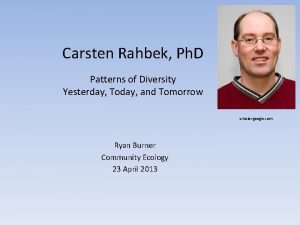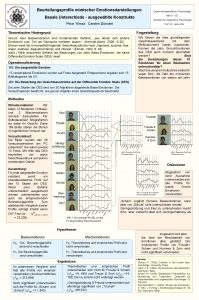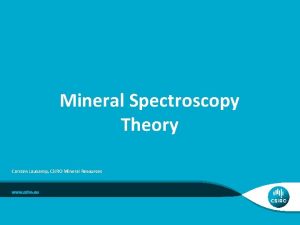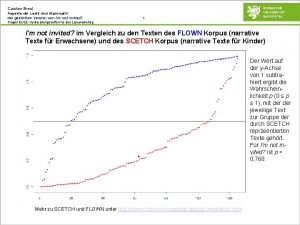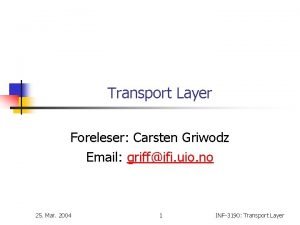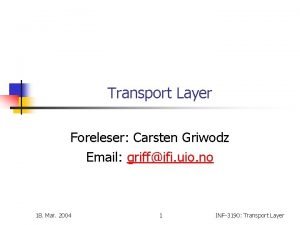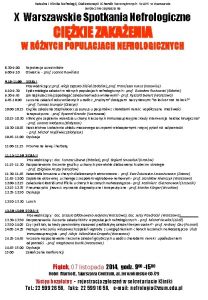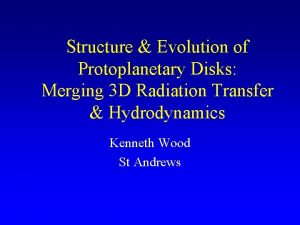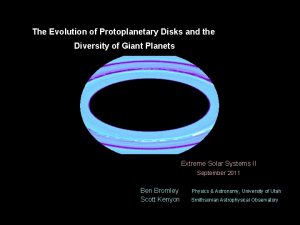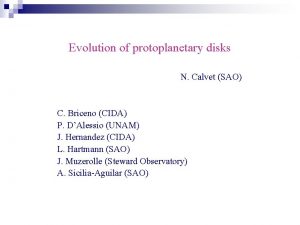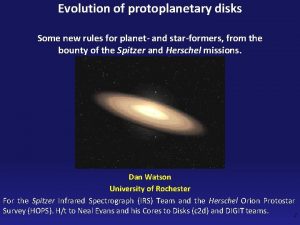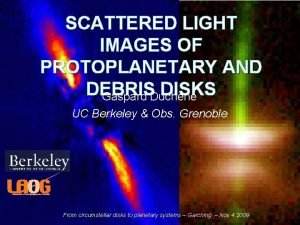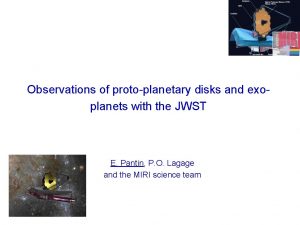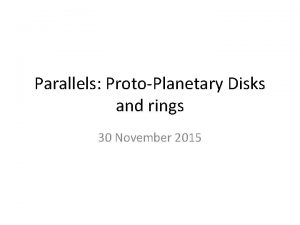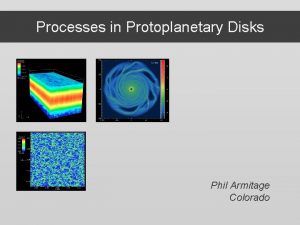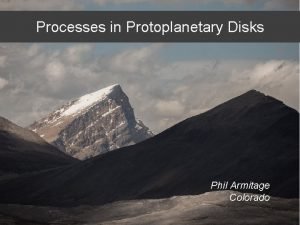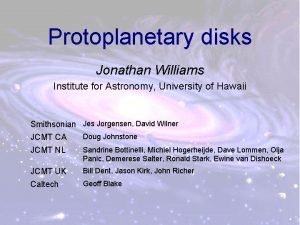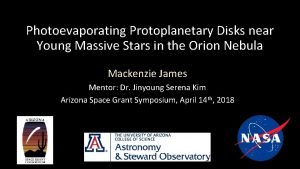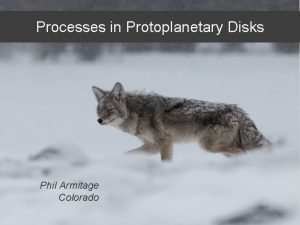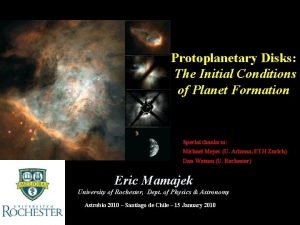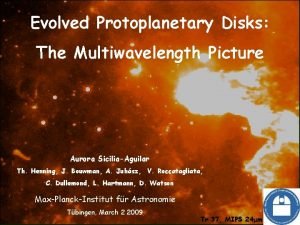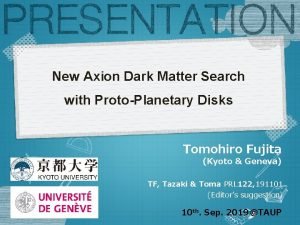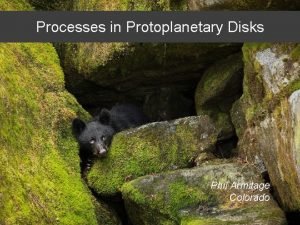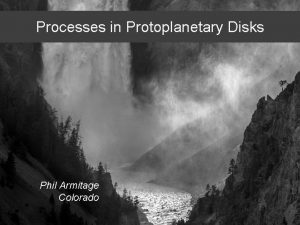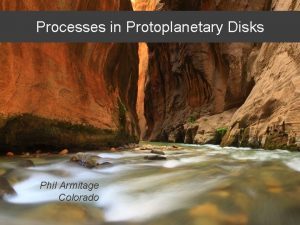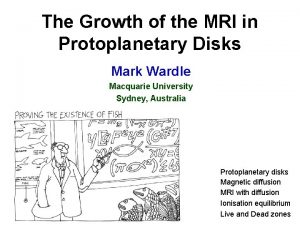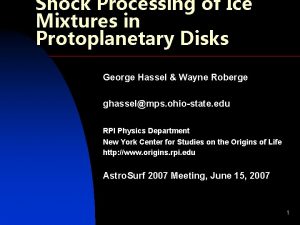Structure and Evolution of Protoplanetary Disks Carsten Dominik






















































- Slides: 54

Structure and Evolution of Protoplanetary Disks Carsten Dominik University of Amsterdam Radboud University Nijmegen

What would we like to know? • Formation and Evolution • Spectral Energy Distributions – and what they do and don’t tell us • Grains – Sizes – Composition – Distribution as function of r, z, t • Gas – Mass – Composition – Distribution as function of r, z, t • Dynamics – Rotation and inflow – Disk winds – Viscosity, turbulence, accretion, instabilities

Figure from Greene 2001)

Disks in a nutshell • Infalling matter has non-zero angular momentum, lands on rotation plane away from star • Star mass dominates, matter on largely Keplerian orbits • Some kind of viscosity couples different annuli of the disk, matter spreads, most falls onto star, some mass moves outward and carries angular momentum • As infall stops, disk mass decreases, eventually disappears into star, planets, or space!

Formation & viscous spreading of disk Fig. from C. Dullemond

Formation & viscous spreading of disk Hueso & Guillot (2005)

Evolution of disks with time • Disks live a few million years Near-IR disk fraction J. Alves L. Hillenbrand

How large are disks? • Hundreds, up to a thousand AUs – In scattered light – Dust millimeter emission – Images in CO mm lines • Different techniques will give different sizes – The mm continuum probes the dust in the disk midplane – Scattered light and CO probe a layer higher – CO lines are brighter than the dust continuum, so disks are larger in the CO lines than in the continuum – Disk size will depend on sensitivity unless sharp outer edge • Surface density - Little direct information in the inner disk - Measured in the outer disk (R>30 AU) with continuum maps� S -1 r

Pre-MS disks are big DM Tau 0. 5 Msun 850 AU GM Aur 0. 8 Msun 500 AU Lk. Ca 15 1 Msun 500 -600 AU MWC 480 2 Msun 450 AU HD 163296 2. 4 Msun 550 AU AB Aur 2. 3 Msun 1000 AU HD 34282 2 Msun 800 AU

Disk masses • Dust mass from submm flux, assume k(1 mm), gas-to-dust ratio = 100 Mdisk ~ 0. 001 - 0. 1 Msun if k(1 mm)~1 cm 2/g

Dynamics in viscous disk • Keplerian rotation: vφ=(GM*/R*)1/2 • Radial drift toward the star: v. R~ cs H/R • No vertical motions: vz=0 • Turbulence – vt < cs << vφ

Rotation from CO mm lines: a velocity gradient across the major axis [Isella et al. 2006] HD 163296 : 12 CO J=2 -1 N E Mstar = 2. 0 0. 5 Msun incl = 45°

Deviations from Keplerian: • Hogerheijde 2001 – infall in TMC 1 • Pietu et al 2005 – V R 0. 41 +/- 0. 01 in AB Aur Turbulence in the outer disk is very hard to measure

Disk shape and composition • Gas and dust are initially well mixed • Dust dominates the opacity at almost any wavelength • Disk is thick because of hydrostatic equilibrium (pressure against gravity). – Density decreases exponentially with height – When small grains exist and are well mixed, stellar radiation is absorbed at about 4 pressure scale heights.

Disks contain warm dust around a star - what it heating the dust? 1. Viscous dissipation (~(M 1/2/r 3 * d. M/dt) 2. Stellar radiation (~L*/r 2) T Tauri HAe. Be

Disk emission Star Disk

Dust, Gas, Radiation H PA UV Hot gas CO, H 2 O dead? H PA , s rain CR, X lg l a m s small(? ), large grains Mo Ice mantles, H 3+ PDR lecu : ato les: CI, CO Ne. I ms, ion , HC s, sm I. . . O +. all m. . olec ules

Gas temperature gets very high in upper layers Woitke, Kamp, Thi 2009

General structure of the disk Fig. from Dullemond et al, PPV

Submm allows us to look at the whole disk

V-band 24 um 33 um Mulders et al in prep

The snowline, depending on accretion Min et al 2010



Sources of Water in the disk: photo desorption gas phase formation route + photo dissociation freeze-out/reformation

shallow�sample, ~2000 sec DM Tau • Integrated for 198 min at 557 GHz and 328 m at 1113 GHz • No significant detection of either ortho or para H 2 O • weak 6σ detection of 557 GHz line (110 - 101) • Models indicate ice depletion (due to settling? ) Bergin et al 2010

Grain sizes and spatial distribution

§ § Main grain size processes Settling Radial Drift Turbulent mixing and concentration Gravitational instabilities?

Effects of dust settling Dullemond & Dominik (2004)

SED differences in FIR As before, but replacing mass by large grains at the equator instead of removing it

Evidence for grain growth Small grain Large grain v Boekel et al 2003

Most. T Tauri disks shows evidence for grain growth Kessler-Silacci et al. 2006, 2007 10 mm band 20 mm band Obs Model

Radial drift of particles 1 AU in 100 ys Weidenschilling 1977, Brauer et al 2008

Radial motion changes disk sizes • Mm-sized grains move to below 100 AU in 105 years • Porosity increases life Takeuchi, time Clarke, Lin 2005

Sources of relative velocities • Brownian motion • Settling • Radial drift • Coupling and decoupling to turbulent eddies – Complex expression depending on details of turbulence and dust properties (e. g. Ormel & Cuzzi 2007)

Relative velocities: Total Brauer et al 2008

Coagulation only, different velocity sources Brauer et al 2008

Effects of radial motion 1 m 1 cm Brauer et al 2008

With fragmentation at 10 m/s 1 m 1 cm Brauer et al 2008

With higher fragmentation speed 30 m/s 1 m 1 cm Brauer et al 2008

Observed: Large grains in outer disk Optically thin disk: Testi et al 2001

Birnstil et al 2010

The inner disk

Isella and Natta 2005

The location of the inner rim • Equilibrium temperature of a dust grain in free space • Including backwarming

Optically thin dust inside the rim

Moving the rim with refractory shields Kama et al 2009

A selection of inner rim structures

Inner holes: transition objects Rin=0. 03, 1, 10, 30 AU Calvet et al. 2005

Disk evaporation • Photoevaporation by EUV, FUV and X-ray photons, @ <10 and >30 AU • Life times enough for planet formation • Disk survives for 106 years after gap formation • Short-lived disks for M*>3 Mo Gorti et al 2009

Lk. Ca 15 and disk geometry See also talk by Nuria Calvet Espalliat et al 2007 -2010 Mulders et al 2010

Optically thin matter in the inner disk? Benisty et al 2010

Clearing out the disk when a gap is already present Chiang & Murray-Clay 2007 Dominik & Dullemond, in preparation

Summary • Disks are everywhere, with a wide variety of properties • Planet formation by just coagulation seems to be too hard • The presence of mm-cm grains in the outer disk is not fully understood • Inner gaps and optically thin material in these gaps are a hot topic right now
 Carsten dominik
Carsten dominik Protoplanetary disk
Protoplanetary disk A mechanism that spins reads and writes disks
A mechanism that spins reads and writes disks Disks and tapes can be stored ------- a library. eng101
Disks and tapes can be stored ------- a library. eng101 Vladimir kolmogorov
Vladimir kolmogorov Tower of hanoi 4 disks
Tower of hanoi 4 disks Redundant array of inexpensive disk
Redundant array of inexpensive disk Types of floppy disk
Types of floppy disk What is magnetic storage devices
What is magnetic storage devices Types of magnetic disks
Types of magnetic disks Redundancy array of independent disk
Redundancy array of independent disk Probability learning objectives
Probability learning objectives Azure managed disks
Azure managed disks Anti raid nedir
Anti raid nedir Redundant array of independent disks
Redundant array of independent disks Conquest data disks
Conquest data disks Carsten olsson
Carsten olsson Carsten griwodz
Carsten griwodz Carsten mathes
Carsten mathes Carsten griwodz
Carsten griwodz Carsten honerkamp
Carsten honerkamp Carsten rahbek
Carsten rahbek Carsten gerke
Carsten gerke Carsten dünckel
Carsten dünckel Gentofterenden kort
Gentofterenden kort Carsten laukamp
Carsten laukamp Carsten dahl mørch
Carsten dahl mørch Carsten zornig
Carsten zornig Carsten vagn hansen kolesterol
Carsten vagn hansen kolesterol Dr. carsten winkler
Dr. carsten winkler Breul uni wuppertal
Breul uni wuppertal Carsten griwodz
Carsten griwodz Prof. carsten grüllich
Prof. carsten grüllich Uio email
Uio email Carsten ingerslev
Carsten ingerslev Indkomstmetoden
Indkomstmetoden Transport layer
Transport layer Carsten corneliussen
Carsten corneliussen Carsten winkler fond of
Carsten winkler fond of Carsten hornstrup
Carsten hornstrup Carsten jakobi uni mainz
Carsten jakobi uni mainz Dominik klaes
Dominik klaes Trzustka niepowiększona hyperechogeniczna
Trzustka niepowiększona hyperechogeniczna Kinal ibu
Kinal ibu Dominik kalajdzic
Dominik kalajdzic Logon pwr
Logon pwr Dominik wojtczak lekarz szczecin
Dominik wojtczak lekarz szczecin Dominik to
Dominik to Dominik wojtczak lekarz
Dominik wojtczak lekarz Richard dominik
Richard dominik Dominik drozd
Dominik drozd Dominik wiedenhofer
Dominik wiedenhofer Justyna oleszkiewicz
Justyna oleszkiewicz św. dominik savio film dla dzieci
św. dominik savio film dla dzieci Stopnie oparzenia
Stopnie oparzenia
